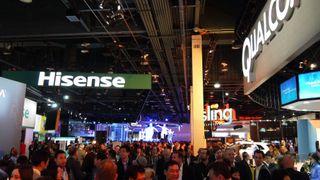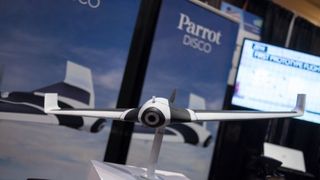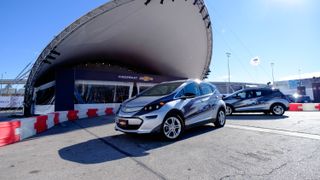CES 2016 was all about refinements and realizations – not revelations
Opinion: And there's every reason to be excited

We look to CES at the start of every year to depict a bright future of new technologies that we've never seen before. You know, that World's Fair vibe that's all but a distant memory?
Coming hot off of CES 2016, we didn't see much of that.
However, what we saw was perhaps even more exciting: the promises of the last few years' shows finally realized. This year's CES proved that ideas like 4K TV (with content to match), autonomous (or just cooler, approachable) robots and drones, (decent) virtual reality and electric vehicles (with realistic range and price) aren't the tech of years to come, but this year.

The next phase of television approaches
Gigantic televisions pumping out pixels in the several millions have been a hallmark of CES for years now, but it's only now in 2016 that they've been realized as an approachable reality. The latest Samsung SUHD TV with Quantum Dot is one (seriously impressive) thing, but TCL's likely affordable 4K TVs is another entirely.
But even more important is that the content to support these televisions is ramping up faster than ever. While not a CES announcement, we can expect DirecTV to start broadcasting in 4K later this year, for instance.
Meanwhile, Ultra HD Blu-ray saw even more support at the show in the Panasonic DMP-UB900 and Sony's commitment to support Dolby Atmos in its 4K Blu-rays in the coming year. Not to mention Dolby Laboratories' DolbyVision HDR tech is found in just about every major TV makers' sets shown off last week.
Black Friday 2015 may have seen 4K TV prices drop to levels approachable by plebeians like you and me, but 2016 will be the year to dive in if there ever was one.
Get daily insight, inspiration and deals in your inbox
Get the hottest deals available in your inbox plus news, reviews, opinion, analysis and more from the TechRadar team.

Drones start truly taking off
Those remote-controlled aircraft that have captured the imaginations of would-be aviation enthusiasts have been around for a few years now, but CES 2016 catapulted them forward in new and interesting ways.
The Parrot Disco drone, for example, marks one of the first to adopt a single-propeller, one-directional flight pattern and design. (Think of a drone in the style of a stealth bomber that you can throw like a paper airplane.)
What's even more exciting is that the thing can fly as fast as 50 miles per hour for 45 minutes. Considering that most quadcopter drones can hover for barely 30 minutes, this is a marked improvement.
Thanks to technologies like Intel's RealSense camera, drones have grown capable of flying themselves in various environments. Using the chip maker's 3D depth-sensing optics, Yuneec's Typhoon H drone showed off its ability to accurately evaluate and avoid obstacles during the Intel keynote (not to mention Intel helped spur mass adoption of wearables in athletics with its Curie platform and a deal with the X-Games).
Sure, these improvements are huge for fans of drones, but their applications in fields like emergency response and filmmaking are simply enormous. Now, just imagine when firms start strapping 360-degree cameras to these things. (Ahem, GoPro.)

Virtual reality hits prime time
VR headsets have been a focal point of CES for the past few years, but only as a vision of the near future that was awfully rough around the edges. But, at this year's CES, both Oculus and HTC showed off their nigh consumer-ready headsets, and they've come a long, long way.
The sense of presence, or the impression put forth that the user is within another space while using the device, has improved drastically in both the HTC Vive Pre and Oculus Rift. But almost more important is that the devices' external sensors have seen vast upgrades, especially HTC and Valve's solution.
To ensure a safer, more comfortable experience under the headset, the Vive Pre uses a forward-facing camera, a series of sensors and some clever software to create an artificial bounding box in your home environment. This way, you won't run away from that virtual dragon into a real wall.
Sure, VR has a long way to go in areas like spatial audio, shared experiences and straight up resolution, but from what I've seen this week, what these companies have developed so far is definitely ready for the public. That said, price remains the tallest hurdle, and likely will for at least another year.

CES 2016: a year of making good on promises
This year's CES didn't unveil any particularly revolutionary technologies, but rather helped display the longtime-coming (albeit inevitable) realizations of tech at shows from the past few years. Just look at the Chevrolet Bolt.
Sure, electric vehicles have been on the road for a few years already, but unless you paid a veritable fortune for one, you aren't getting very far on a charge. Chevy's latest electric vehicle will bring a 200-mile electric range to the sub $30,000 price segment when it lands this year.
While still not exactly a price for mass adoption, it's a huge leap forward in putting electric drive train technology into the hands of more people. The Chevy Bolt is the snowball that will lead the avalanche, so to speak.
No, we didn't see that one piece of surprising new technology that will create an industry or transform our lives or entertainment. What we saw was the refinement of several technologies that will change industries this very year, making good on the promises of CES's of yesteryear, and that alone is worth plenty of hype.
Plus, I sure laughed a lot at this year's CES, so there's that:
- Now, let's get ready for MWC 2016
Joe Osborne is the Senior Technology Editor at Insider Inc. His role is to leads the technology coverage team for the Business Insider Shopping team, facilitating expert reviews, comprehensive buying guides, snap deals news and more. Previously, Joe was TechRadar's US computing editor, leading reviews of everything from gaming PCs to internal components and accessories. In his spare time, Joe is a renowned Dungeons and Dragons dungeon master – and arguably the nicest man in tech.

